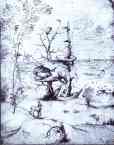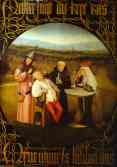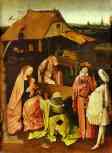Hieronymus Bosch Biography
Bosch's pictures have always fascinated viewers, but in earlier centuries it was widely assumed that his diabolic scenes were intended merely to amuse or titillate, most people regarded him as "the inventor of monsters and chimeras." Philip II, though, collected his works more for education than for entertainment. A Dutch art historian in the early 17th century described Bosch's paintings chiefly as "wondrous and strange fantasies" often less pleasant than gruesome to look at'. In the 20th century, however, scholars decided that Bosch's art has a more profound significance, and there have been many attempts to explain its origins and meaning. Some writers saw him as a sort of 15th century surrealist and linked his name with that of Salvator Dali. For others, Bosch's art reflects mysterious practices of the Middle Ages. No matter what explanation and comprehension of his art might be, Bosch remains the most extravagant painter of his time.
Bosch lived and worked in "s-Hertogenbosch, the place from which he takes his name, a fairly quiet Dutch city. Bosch's ancestors settled in "s-Hertogenbosch in the late 14th or early 15th century. Their family name, Van Aken, suggests that they originally came from the German town of Aachen. In 1430-31 appears the first reference to Bosch's grandfather, Jan van Aken, who died in 1454. Jan had 5 sons, at least four of them were painters; one of these, Anthonius van Aken (died c.1478), was the father of Hieronymus Bosch. He had 2 brothers and a sister; brother Goossen was also a painter. His training as a painter Bosch, most probably, received in the family. Some time between 1479 and 1481 Bosch married Aleyt Goyaerts van den Meervenne, evidently some years his senior. She came from a good family and had considerable wealth of her own.
In 1486-87, Bosch's name appears for the first time in the membership lists of the Brotherhood of Our Lady, with which he was closely associated for the rest of his life. This brotherhood was one of the many groups devoted to the worship of the Virgin, which flourished in the late Middle Ages. The Brotherhood of Our Lady of's-Hertogenbosch was a large and wealthy organization, it must have contributed significantly to the religious and cultural life of the city. They also commissioned works of art to embellish the chapel of Our Lady. Most of Bosch's family belonged to the Brotherhood, and were employed by them in various tasks. There is no documentary evidence that Bosch ever left his home town. One final entry in the accounts of the Brotherhood of Our Lady records Bosch's death in 1516.
Numerous paintings bearing Bosch's name can be found in museums and private collections in Europe and the United States. Many of these are only copies or imitations of his original compositions, but over thirty pictures and a small group of drawings can be attributed to him with reasonable certainty. Except for his early works, however, the chronology of these paintings is difficult to determine with any precision.
Bibliography
Hieronymus Bosch. by G. Fomin. Moscow. 1974.
Hieronymus Bosch. by J. Fränger. Dresden. 1975.
Hieronymus Bosch. Moscow. 1991.
Painting of Europe. XIII-XX centuries. Encyclopedic Dictionary. Moscow. Iskusstvo. 1999.
Hieronymus Bosch by Walter S. Gibson. Thames & Hudson, 1985.
Bosch: C. 1450 1516 Between Heaven and Hell (Basic Series: Art) by Walter Bosing. TASCHEN America Llc, 2000.
Bosch: Master of the Grotesque--His Life in Paintings by Hieronymus Bosch, Alessia Devitini Dufour. DK Publishing, 1999.
Bosch by Federico Zeri. NDE Publishing,, 2001.
Masters of Art: Bosch by Carl Linfert. Harry N. Abrams, 1989.
The Secret Heresy of Hieronymus Bosch by Lynda Harris. Floris Books, 2002.
Hieronymus Bosch: The Complete Paintings and Drawings by Jos Koldeweij, Paul Vandenbroeck. Harry N. Abrams, 2001.
Hieronymus Bosch: Garden of Earthly Delights by Hans Belting. Prestel USA, 2002.
- The Tree Man.

1470s. Pen and bistre on paper. Albertina, Vienna, Austria.
- The Stone Operation.

1475-1480. Oil on panel. Museo del Prado, Madrid, Spain. Read Note.
- Epiphany.

1480-1490. Oil on panel. Philadelphia Museum of Art, Philadelphia, PA, USA. 1480-1490. Read Note.